Key takeaways:
- Collaboration in the industry combines creativity and strategy, fostering innovation and unity among stakeholders.
- Key stakeholders in music awards include artists, industry professionals, and the voting body, each contributing to the recognition process.
- Effective collaboration involves open communication, flexibility, and creating an environment for shared goals and creativity.
- Building long-term relationships through consistent engagement and follow-up strengthens networks and enhances collaborative success.
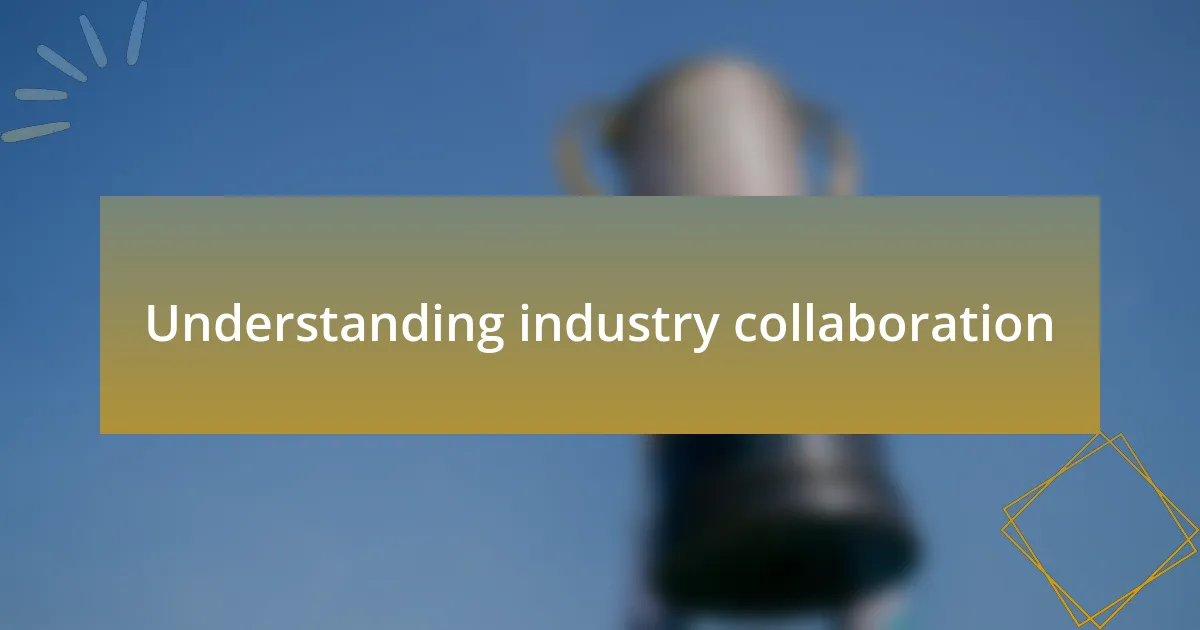
Understanding industry collaboration
When considering industry collaboration, I often reflect on the mix of creativity and strategy that it demands. For instance, I remember vividly attending a roundtable where artists, producers, and marketers brainstormed over coffee. It was fascinating to see how ideas evolved simply through conversation; collaboration can ignite fresh perspectives and lead to innovative projects.
What I’ve come to appreciate is that collaboration isn’t just a transactional affair; it’s also deeply relational. I recall partnering on a promotional campaign for an up-and-coming band and realized the power of shared passion. It felt like we were all pushing toward a common goal, and that unity sparked a palpable energy that propelled our efforts forward.
Moreover, isn’t it intriguing how collaboration can redefine success? I’ve often found myself asking whether the outcome of a project is more rewarding when there’s a collective effort behind it. For me, the memories created and the connections built through these collaborations have become invaluable, often making the journey just as important as the destination.
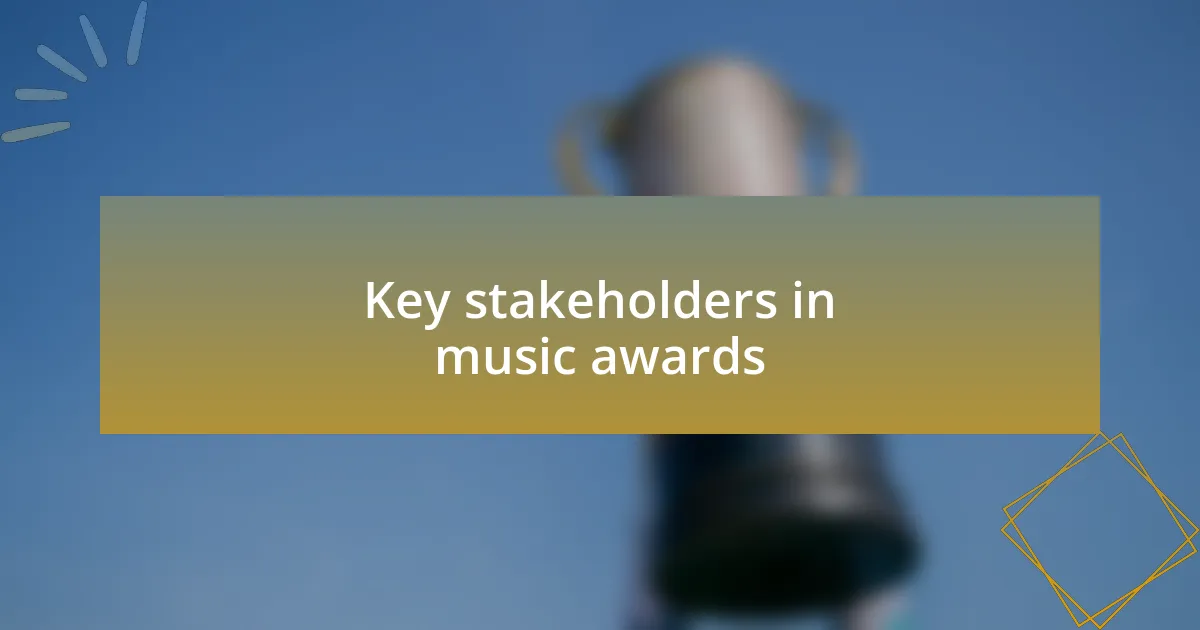
Key stakeholders in music awards
When it comes to music awards, one of the key stakeholders is, of course, the artists themselves. I’ve seen firsthand how their passion not only fuels the industry but also shapes the very fabric of these awards. Whether they’re established stars or emerging talents, each artist brings a unique narrative that enriches the celebration, making it feel more personal and relatable.
Industry professionals, including producers and record labels, also play a critical role in music awards. I remember working with a label that had a clear vision for one of their artists. The level of commitment they invested in the artist’s journey made the eventual recognition at an awards show feel like a shared victory. Their behind-the-scenes efforts often go unnoticed, yet they are essential in ensuring that music, and the artists behind it, are celebrated.
Another significant stakeholder is the voting body that determines the winners. Engaging with members of this community has always been eye-opening for me. It’s interesting to consider how their diverse perspectives can influence outcomes. I often ask myself how their decisions reflect broader trends in music, reminding me that recognition in the industry is not simply about talent but about the continuum of culture and art.
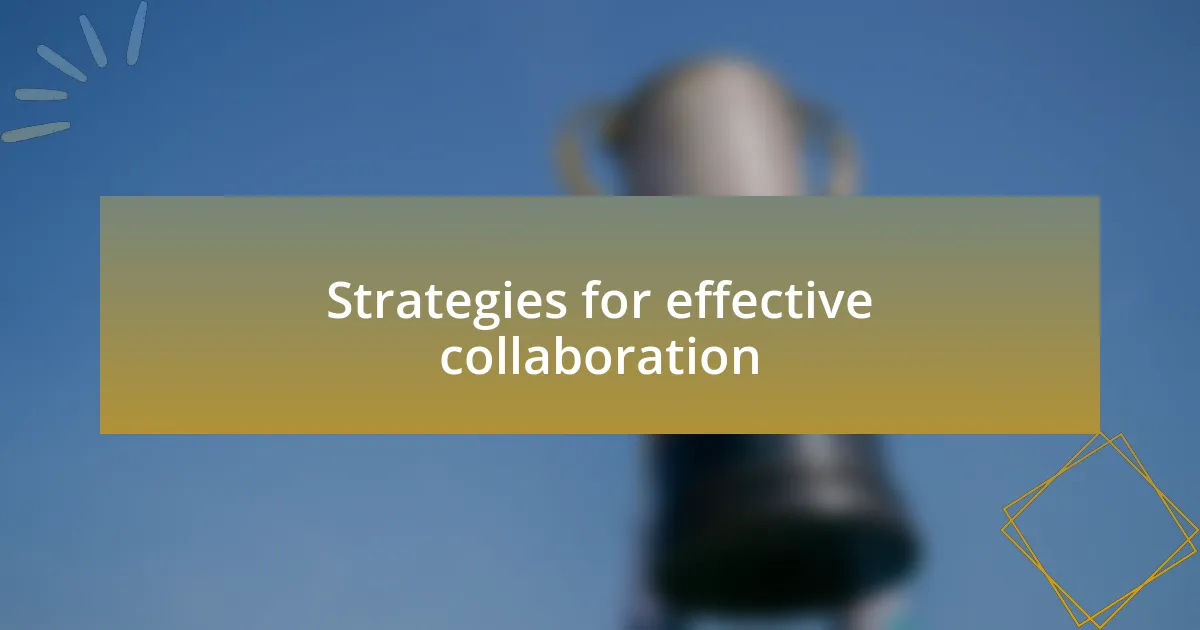
Strategies for effective collaboration
Collaboration in the music awards landscape requires a strategic approach to bring diverse voices together effectively. I recall a time when I facilitated a roundtable discussion among artists, producers, and voting members. By creating a space for open dialogue, we uncovered shared goals and passions that transformed what could have been a contentious interaction into a collaborative brainstorming session. Have you ever noticed how meaningful conversations can lead to innovative solutions? It’s incredible how simply bringing people together can spark creativity.
Effective collaboration also hinges on clear communication channels. During one of my projects, I established regular check-ins with stakeholders, allowing everyone to voice their opinions and concerns. I found that this practice not only kept projects on track but also fostered a sense of ownership among the team. Can you imagine how much smoother things run when everyone feels heard? Transparency can bridge gaps in perspectives and lead to more cohesive outcomes.
Lastly, embracing flexibility is essential. In one instance, a well-planned event had to pivot due to unforeseen circumstances. Instead of seeing this as a setback, I encouraged my team to innovate on the fly, which ultimately led to an unforgettable virtual experience. Flexibility in collaboration means being ready to adapt to change and think outside the box. Have you ever found yourself in a similar situation? It’s often in these moments that the most memorable collaborations come to life.
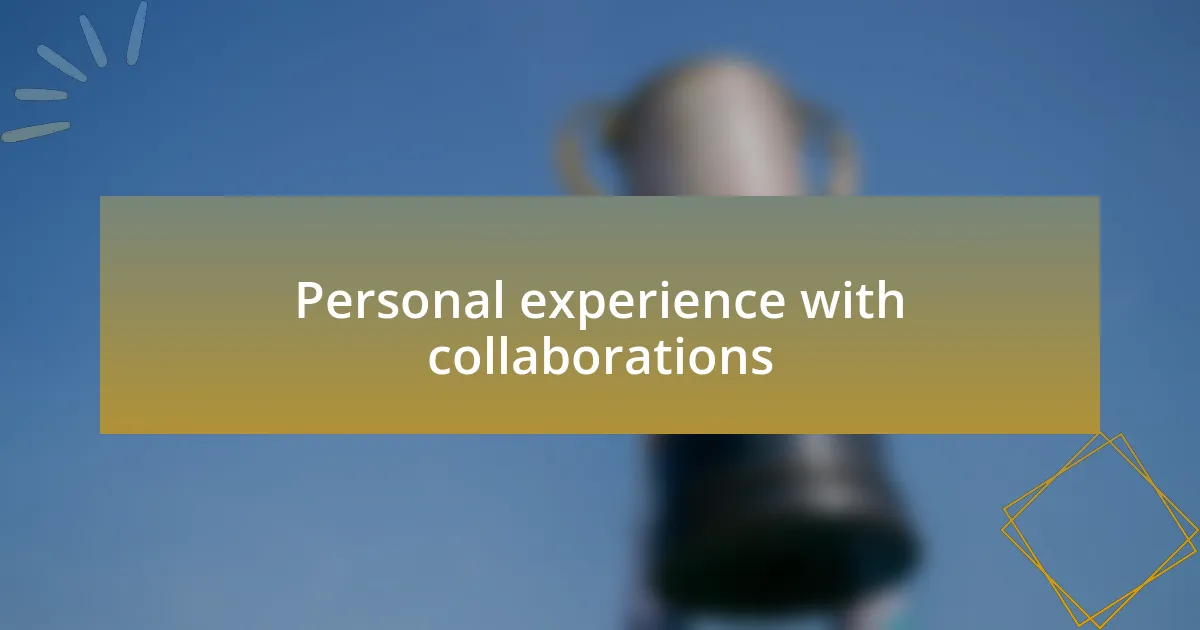
Personal experience with collaborations
I remember my first big collaboration for a music awards show, where I worked alongside a diverse group of artists from various genres. Initially, I felt overwhelmed by the mix of personalities and creative visions. But as we shared our stories, I saw how our unique backgrounds sparked genuine excitement. It made me realize that vulnerability in sharing our experiences can actually help build trust and foster creativity.
One moment that stands out to me was when I partnered with a rising star who had faced significant hardships before gaining recognition. Listening to her narrative not only inspired our project but also connected the team on a deeper level. It’s fascinating how personal stories can transform an ordinary collaboration into something profound. Have you ever felt that special bond formed through shared vulnerability?
On another occasion, I collaborated on a charity single that brought together both established and new artists. The energy in the room was electric, yet we also faced challenges with differing opinions on the musical direction. Instead of letting those differences divide us, I initiated a jam session that allowed everyone to contribute their unique styles. In that spontaneous moment of creativity, I learned that embracing our differences can lead to beautiful and unexpected results. How often do we consciously seek out differences to fuel our creativity?
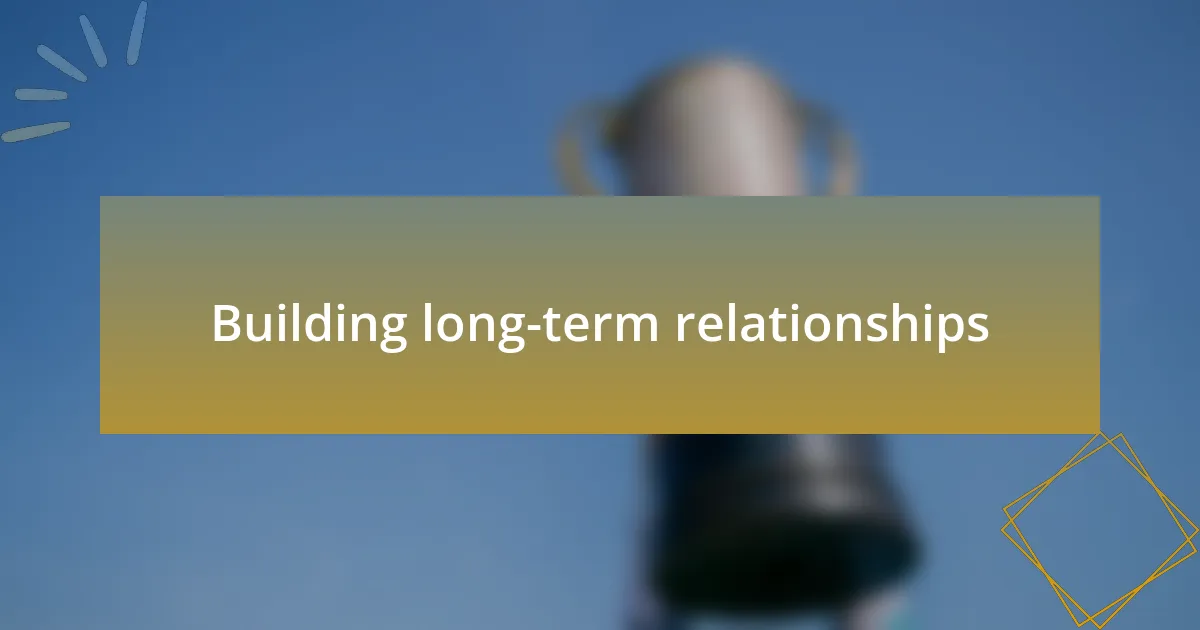
Building long-term relationships
Building long-term relationships requires consistent investment in the connections we’ve formed. I recall establishing a partnership with a seasoned producer who initially seemed intimidating. However, by regularly reaching out for feedback on my projects, I discovered that he genuinely appreciated collaboration. That ongoing communication transformed our initial meetings into a lasting friendship built on mutual respect and shared experiences. Have you ever noticed how persistence in relationships often opens doors?
One key aspect I’ve noticed in building these enduring connections is the power of follow-up. After a successful award show, I made it a point to reach out to every participant with a personal message expressing gratitude. This simple act not only reinforced the bonds we created during the event but also made them feel valued in the long run. How often do we take the time to reflect on our collaborations and celebrate those moments? In my experience, this small gesture cultivates loyalty and trust.
Ultimately, establishing longevity in these relationships doesn’t just happen overnight; it’s nurtured over time. I’ve found that attending industry events regularly, whether big or small, helps maintain these connections. I often meet the same faces year after year, and these interactions evolve from casual encounters into lasting partnerships. It’s intriguing to consider how the music industry is a web of relationships built on shared goals and experiences. Do you see the value in consistently showing up?
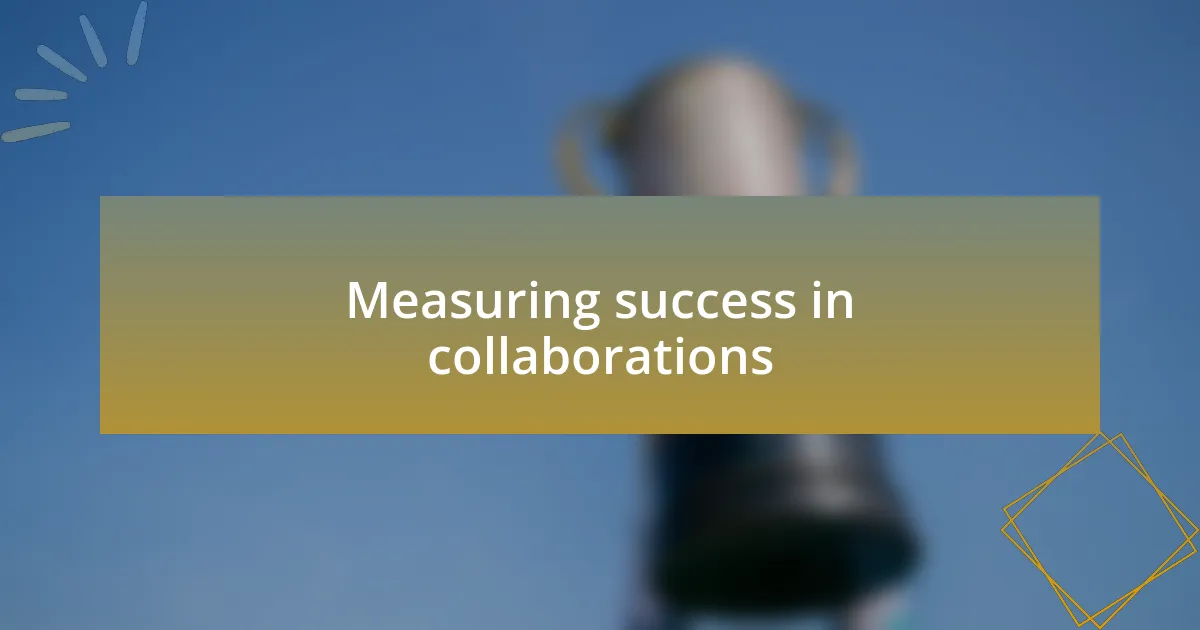
Measuring success in collaborations
Measuring success in collaborations can often be subjective, but I find that establishing clear benchmarks is essential. For instance, after working on a joint project with a well-known artist, I kept a close eye on metrics like social media engagement and listener feedback. When we saw a significant increase in both areas, it validated our partnership and showed that our creative synergy resonated with audiences. How do you determine whether a collaboration was genuinely impactful?
I’ve also experienced the value of post-collaboration reflection. Following a successful campaign with a music label, I gathered insights from all involved parties. The feedback revealed that we not only met our goals but exceeded expectations in areas like brand awareness and fan outreach. Reflecting on these outcomes helped me calibrate future collaborations. Have you ever taken the time to analyze what worked well and what could be improved?
Ultimately, I believe success in collaborations is reflected in the long-term relationships forged through shared experiences. I’ve noticed that when we sincerely support each other’s projects after our joint efforts, it creates a ripple effect that strengthens our networks. Each follow-up performance or joint appearance can serve as a testament to our commitment to one another. How might you nurture these collaborations to ensure continued success?